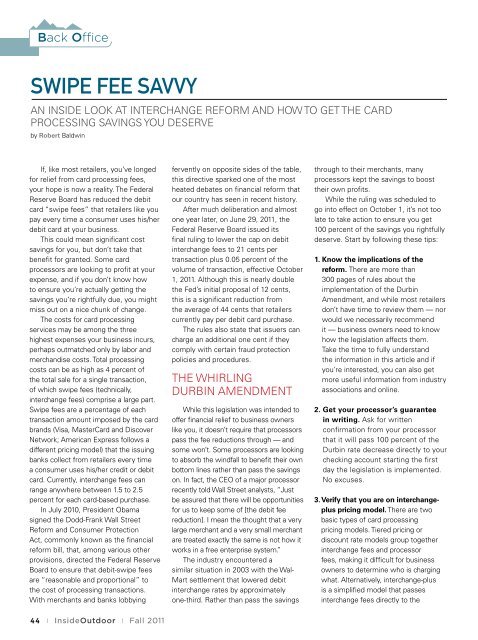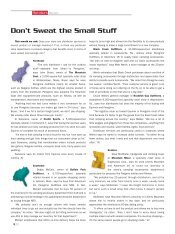Fall - InsideOutdoor Magazine
Fall - InsideOutdoor Magazine
Fall - InsideOutdoor Magazine
You also want an ePaper? Increase the reach of your titles
YUMPU automatically turns print PDFs into web optimized ePapers that Google loves.
Back Office<br />
Swipe Fee Savvy<br />
An inside look at interchange reform and how to get the card<br />
processing savings you deserve<br />
by Robert Baldwin<br />
If, like most retailers, you’ve longed<br />
for relief from card processing fees,<br />
your hope is now a reality. The Federal<br />
Reserve Board has reduced the debit<br />
card “swipe fees” that retailers like you<br />
pay every time a consumer uses his/her<br />
debit card at your business.<br />
This could mean significant cost<br />
savings for you, but don’t take that<br />
benefit for granted. Some card<br />
processors are looking to profit at your<br />
expense, and if you don’t know how<br />
to ensure you’re actually getting the<br />
savings you’re rightfully due, you might<br />
miss out on a nice chunk of change.<br />
The costs for card processing<br />
services may be among the three<br />
highest expenses your business incurs,<br />
perhaps outmatched only by labor and<br />
merchandise costs. Total processing<br />
costs can be as high as 4 percent of<br />
the total sale for a single transaction,<br />
of which swipe fees (technically,<br />
interchange fees) comprise a large part.<br />
Swipe fees are a percentage of each<br />
transaction amount imposed by the card<br />
brands (Visa, MasterCard and Discover<br />
Network; American Express follows a<br />
different pricing model) that the issuing<br />
banks collect from retailers every time<br />
a consumer uses his/her credit or debit<br />
card. Currently, interchange fees can<br />
range anywhere between 1.5 to 2.5<br />
percent for each card-based purchase.<br />
In July 2010, President Obama<br />
signed the Dodd-Frank Wall Street<br />
Reform and Consumer Protection<br />
Act, commonly known as the financial<br />
reform bill, that, among various other<br />
provisions, directed the Federal Reserve<br />
Board to ensure that debit-swipe fees<br />
are “reasonable and proportional” to<br />
the cost of processing transactions.<br />
With merchants and banks lobbying<br />
fervently on opposite sides of the table,<br />
this directive sparked one of the most<br />
heated debates on financial reform that<br />
our country has seen in recent history.<br />
After much deliberation and almost<br />
one year later, on June 29, 2011, the<br />
Federal Reserve Board issued its<br />
final ruling to lower the cap on debit<br />
interchange fees to 21 cents per<br />
transaction plus 0.05 percent of the<br />
volume of transaction, effective October<br />
1, 2011. Although this is nearly double<br />
the Fed’s initial proposal of 12 cents,<br />
this is a significant reduction from<br />
the average of 44 cents that retailers<br />
currently pay per debit card purchase.<br />
The rules also state that issuers can<br />
charge an additional one cent if they<br />
comply with certain fraud protection<br />
policies and procedures.<br />
The Whirling<br />
Durbin Amendment<br />
While this legislation was intended to<br />
offer financial relief to business owners<br />
like you, it doesn’t require that processors<br />
pass the fee reductions through — and<br />
some won’t. Some processors are looking<br />
to absorb the windfall to benefit their own<br />
bottom lines rather than pass the savings<br />
on. In fact, the CEO of a major processor<br />
recently told Wall Street analysts, “Just<br />
be assured that there will be opportunities<br />
for us to keep some of [the debit fee<br />
reduction]. I mean the thought that a very<br />
large merchant and a very small merchant<br />
are treated exactly the same is not how it<br />
works in a free enterprise system.”<br />
The industry encountered a<br />
similar situation in 2003 with the Wal-<br />
Mart settlement that lowered debit<br />
interchange rates by approximately<br />
one-third. Rather than pass the savings<br />
through to their merchants, many<br />
processors kept the savings to boost<br />
their own profits.<br />
While the ruling was scheduled to<br />
go into effect on October 1, it’s not too<br />
late to take action to ensure you get<br />
100 percent of the savings you rightfully<br />
deserve. Start by following these tips:<br />
1. Know the implications of the<br />
reform. There are more than<br />
300 pages of rules about the<br />
implementation of the Durbin<br />
Amendment, and while most retailers<br />
don’t have time to review them — nor<br />
would we necessarily recommend<br />
it — business owners need to know<br />
how the legislation affects them.<br />
Take the time to fully understand<br />
the information in this article and if<br />
you’re interested, you can also get<br />
more useful information from industry<br />
associations and online.<br />
2. Get your processor’s guarantee<br />
in writing. Ask for written<br />
confirmation from your processor<br />
that it will pass 100 percent of the<br />
Durbin rate decrease directly to your<br />
checking account starting the first<br />
day the legislation is implemented.<br />
No excuses.<br />
3. Verify that you are on interchangeplus<br />
pricing model. There are two<br />
basic types of card processing<br />
pricing models. Tiered pricing or<br />
discount rate models group together<br />
interchange fees and processor<br />
fees, making it difficult for business<br />
owners to determine who is charging<br />
what. Alternatively, interchange-plus<br />
is a simplified model that passes<br />
interchange fees directly to the<br />
44 | <strong>InsideOutdoor</strong> | <strong>Fall</strong> 2011

















